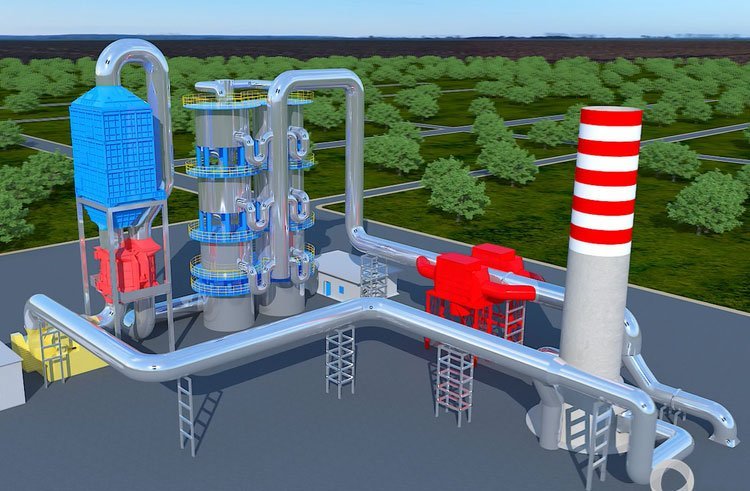Why in the News?
- A high-level expert committee led by Principal Scientific Advisor has suggested that India should not make it mandatory for all coal-based thermal power plants (TPPs) to install Flue Gas Desulphurisation (FGD) units.
Flue Gas Desulfurization (FGD):
Flue Gas:
|
What are the Recommendations of the Committee?
- Using FGDs increases power plant energy usage, which adds to carbon dioxide (CO2) emissions, a greenhouse gas.
- FGD installation should be required only in high-population and critically polluted areas.
- Power plants located within 10 km of Critically Polluted Cities or Non-Attainment Cities are called Category B plants.
- The CPCB identifies Critically Polluted Cities based on the Comprehensive Environmental Pollution Index (CEPI), which assesses air, water, and land pollution.
- A CEPI score above 70 indicates a critically polluted area.
- Non-attainment cities under National Clean Air Programme (NCAP), include 130 cities that consistently violate National Ambient Air Quality Standards (NAAQS).
- These plants may be exempted from installing FGDs, but the decision will be taken case by case after a joint review by the Central Electricity Authority or the Central Pollution Control Board.
- FGDs increase power plants’ Auxiliary Power Consumption (APC), which means more coal is burned to run the FGD units, leading to more CO₂ emissions as compared to SO2 removed.
- This results in approximately 69 million tons of CO₂ emissions being added to the atmosphere (2025–30), while only 17 million tons of SO₂ are reduced.
- The report warns that removing short-lived SO₂ while adding long-lived CO₂ could actually make global warming worse.
What are the Reasons?
- FGDs are expensive and increase power production costs.
- SO₂ levels in the air are already very low. It falls between 10 to 20 micrograms per cubic metre. This is much lower than the allowed limit of 80 micrograms per cubic metre.
- Indian coal has low sulphur, so the SO₂ emissions are not as high as in some other countries, which weakens the case for mass FGD use.
- Cities with FGDs and without FGDs have similar SO₂ levels, and both are within safe limits.
What is the Significance of this Move?
- This move can help power plants save a lot of money by not making them install costly FGD machines.
- It can stop electricity bills from going up for common people.
- It allows the government to make different rules based on where the power plant is and how much it pollutes.
- It can avoid adding more carbon dioxide (CO2) to the air, which causes global warming.
- It focuses on protecting people’s health only in places where it is really needed, instead of applying the same rule everywhere.
What are the Challenges and Way Forward?
Challenges | Way Forward |
| 1.Many plants have not installed FGDs despite old deadlines | 1. Focus FGD rules only on most polluted and populated areas |
| 2. High cost of FGD installation | 2. Allow case-by-case exemptions for low-risk areas |
| 3. Electricity bills may rise due to FGDs | 3. Exempt old or faraway plants to avoid cost rise |
| 4. FGDs may increase CO2 emissions | 4. Balance between reducing SO2 and not increasing the CO2 level and global warming |
| 5. Lack of vendor capacity in India | 5. Promote domestic technology development if needed |
| 6. Environmental groups may raise concerns | 6. Conduct regular air quality checks to ensure health safety |
| 7. Delay in policy response from Environment Ministry | 7. Speed up inter-ministerial coordination and final decision-making |
Conclusion
The committee believes that most power plants in India do not need to install FGDs because SO2 levels are already low and Indian coal has less sulphur. Only plants near big cities or polluted zones should follow strict rules. This change, if accepted by the government, could reduce costs, avoid electricity price hikes, and help manage climate goals. However, the government must ensure that public health and environmental safety are not ignored.
| Ensure IAS Mains Question: Q. The recent recommendation to exempt most thermal power plants from mandatory Flue Gas Desulfurization (FGD) installation reflects a pragmatic shift in India’s environmental regulation strategy. Critically examine this statement in the context of balancing air pollution control and climate change mitigation goals. (250 words) |
| Ensure IAS Prelims Question: Q. Consider the following statements regarding Flue Gas Desulfurization (FGD) units:
How many of the above statements are correct?
Answer: b Explanation:
|





